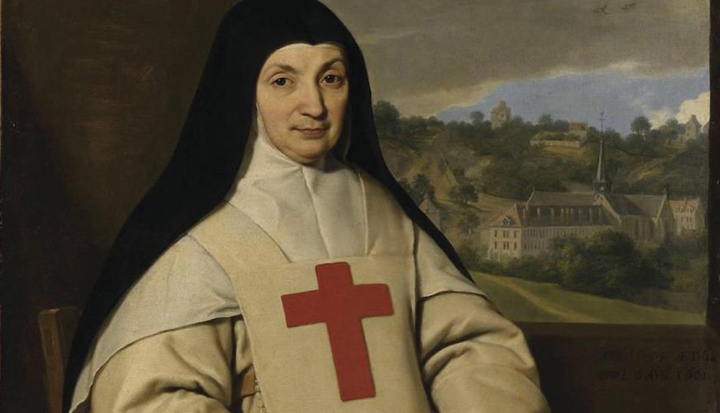Almost a year after the Vatican removed now disgraced former Cardinal Theodore McCarrick from ministry and nearly five months after U.S. bishops met in Baltimore to address the ongoing sexual abuse crisis, many Catholics are feeling frustrated by the slow pace of reform in a scandal-plagued church. These Catholics may find a kindred spirit and cautionary tale in Angélique Arnauld, one of history’s most fascinating, if often forgotten, church reformers.
Born in 1591 to Catholic nobles hungry for ecclesial power and willing to pull a few strings in the corruption-plagued French church to get it, Angélique was named abbess of the prestigious Port-Royal convent near Paris when she was only 7. She was officially installed at age 11, on the same day she received her first communion—a sacrament she only dimly understood.
Angélique spent the next five years drifting in and out of depression-induced illnesses while her mother and an older nun ran the convent for her. When she was 16, a traveling Franciscan preacher inspired her to dedicate her life to Christ and study her faith. Angélique began living her vows of poverty, chastity, and obedience to the hilt, motivating her lukewarm nuns to follow suit.
Over the next decade, Angélique transformed Port-Royal from a haven for spoiled socialites to a bastion of religious rigor. Her nuns rose at 2 a.m. to pray, ate no meat, spoke only once daily during a recreation period, and divided the rest of their hours between hard labor and highly choreographed prayer. It was a grueling life. And in a culture that equated austerity with holiness, it made them spiritual celebrities.
Angélique soon crossed paths with St. Francis de Sales, whom she had long sought as a spiritual director. Francis commended Angélique’s reforms but warned of spiritual dangers lurking in her extreme penances and take-no-prisoners approach to opponents of her reforms. He challenged Angélique to focus less on external feats and harsh reprimands of herself and others than on the interior disciplines of humility and gentleness.
Practice your faith “joyously,” Francis told Angélique. Spend less time griping about your fellow Catholics and corrupt clergy and more time praying for God to purify the church and use you in that work.
Angélique revered Francis but mostly ignored his advice. After he died in 1622, she found a new spiritual director who encouraged her critical spirit: Jean du Vergier de Hauranne, better known as the Abbot of Saint-Cyran and a founding father of the Jansenist heresy.
A mix of moral perfectionism and theological fatalism, Jansenism stressed a forbidding image of God and the futility of human efforts to draw near the divine. Jansenists discouraged regular reception of the sacraments, pronounced salvation out of reach for all but a few, and saw sin lurking everywhere, even in pleasures and virtues that appeared good.
Angélique took to Jansenism as a moth to a flame, and once Port-Royal became its command center, it spread rapidly to the rank-and-file faithful. Terror of God’s judgment became the defining feature of faith for scores of Catholics in France and beyond. Many despaired of salvation. Others forsook faith altogether, and some historians blame backlash against Jansenism for the French Revolution’s militant secularism.
Four popes condemned Jansenism—three in Angélique’s lifetime—but her commitment to its dour doctrines was as absolute as her contempt for its critics. The “Mistress of Jansenism” went to her grave in 1661 at war with the church she had set out to reform, still firing off feisty letters casting herself as a saintly truth teller persecuted by her theological and moral lessers.
The community of Port-Royal died a few decades after Angélique did, thanks largely to pressure from the French crown. Jansenism itself heaved its last public gasp a few decades after that, with the rise and fall of the convulsionnaires, an offshoot group of Jansenists known for beating, cutting, and crucifying one another.
It was an ugly end to Angélique’s dreams of purifying the church. While her impressive body of erudite writings has made Angélique an icon of feminist defiance in some corners of academia, she is mostly forgotten everywhere else.
Angélique’s erstwhile spiritual director, by contrast, is still inspiring Christians four centuries after his death. The books of St. Francis de Sales are perennial favorites among Catholics seeking serenity and spiritual growth in a noisy, complicated world. Francis’ reputation for joy and gentleness even with his theological rivals—of whom he had plenty as bishop of Calvinist-controlled Geneva—was matched only by his diocese’s reputation as a beacon of authentic renewal in a dispiriting age.
Perhaps the divergent legacies of Angélique and Francis have something to teach today’s fed-up faithful: As crucial as righteous anger is in kick-starting church reform, real change requires happy warriors who refuse to let the battle define their faith or steal their joy.
This essay is adapted with permission from The Heart of Perfection: How the Saints Taught Me to Trade My Dream of Perfect for God’s (Simon & Schuster, 2019).
This article also appears in the November 2019 issue of U.S. Catholic (Vol. 84, No. 11, pages 25–27). Click here to subscribe to the magazine.
Image: Wikimedia Commons cc













Add comment